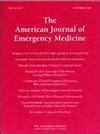Evaluation of an influenza vaccine administration program in the emergency department
IF 2.2
3区 医学
Q1 EMERGENCY MEDICINE
引用次数: 0
Abstract
Background
The Emergency Department (ED) offers the opportunity to expand vaccine prevention interventions. However, the processes, outcomes, and sustainability of ED influenza vaccination remain largely uncharacterized. We report the outcomes of a low-intensity, electronic health record (EHR) facilitated, ED influenza vaccination initiative.
Methods
This retrospective evaluation of an ED influenza vaccination program used existing EHR records of ED encounters from 2019 to 2023 at two affiliated urban EDs. The ED influenza vaccination program launched September 2020 and continued during annual influenza seasons. Nurses assessed eligibility and administered vaccine by protocol based on passive electronic health record best practice advisories (BPAs). Implementation efforts were limited to BPA programming with email and staff meeting announcements. Descriptive statistics were used to compute the primary outcome of the number of ED influenza vaccine administrations by year.
Results
After vaccinating 18 individuals in the year prior to launch, the program vaccinated 271 individuals (225 year 1; 41 year 2; 5 year 3). In the 3-year evaluation period, nurses acknowledged 10,558 (8.9 %) BPAs, of which 116 (1.1 %) were excluded due to contraindications, 10,000 (94.7 %) were documented as “vaccine offer declined”, and 442 (4.2 %) agreed to vaccination.
Conclusion
A nursing driven ED influenza vaccination protocol may enable vaccination, but successful ED influenza vaccination was minimal in this experience featuring limited implementation procedures. The passive BPA was most often not acknowledged and when acknowledged resulted in a high refusal rate possibly due to erroneous documentation. A program of research in ED care processes, staff motivation, and health policy is required to leverage EDs as vaccination sites.
对急诊科流感疫苗注射方案的评价
急诊科(ED)提供了扩大疫苗预防干预的机会。然而,ED流感疫苗接种的过程、结果和可持续性在很大程度上仍未确定。我们报告低强度,电子健康记录(EHR)促进,ED流感疫苗接种倡议的结果。方法:回顾性评估急诊科流感疫苗接种计划,使用两家附属城市急诊科2019年至2023年的现有电子病历记录。ED流感疫苗接种计划于2020年9月启动,并在每年的流感季节继续进行。护士根据基于被动电子健康记录最佳实践咨询(BPAs)的方案评估资格和接种疫苗。实现工作仅限于通过电子邮件和员工会议通知进行BPA编程。描述性统计用于计算按年接种ED流感疫苗次数的主要结局。结果在启动前一年为18人接种疫苗后,该计划接种了271人(225人1年;41年2;5年3)。在3年的评估期内,护士承认10558例(8.9%)双酚a,其中116例(1.1%)因禁忌症被排除,10000例(94.7%)被记录为“拒绝接种”,442例(4.2%)同意接种。结论护理驱动的ED流感疫苗接种方案可以实现疫苗接种,但在实施程序有限的情况下,成功的ED流感疫苗接种很少。被动双酚a通常不被承认,当承认时,可能由于错误的文件导致高拒绝率。需要一个关于急诊科护理过程、员工动机和卫生政策的研究项目,以利用急诊科作为疫苗接种点。
本文章由计算机程序翻译,如有差异,请以英文原文为准。
求助全文
约1分钟内获得全文
求助全文
来源期刊
CiteScore
6.00
自引率
5.60%
发文量
730
审稿时长
42 days
期刊介绍:
A distinctive blend of practicality and scholarliness makes the American Journal of Emergency Medicine a key source for information on emergency medical care. Covering all activities concerned with emergency medicine, it is the journal to turn to for information to help increase the ability to understand, recognize and treat emergency conditions. Issues contain clinical articles, case reports, review articles, editorials, international notes, book reviews and more.

 求助内容:
求助内容: 应助结果提醒方式:
应助结果提醒方式:


